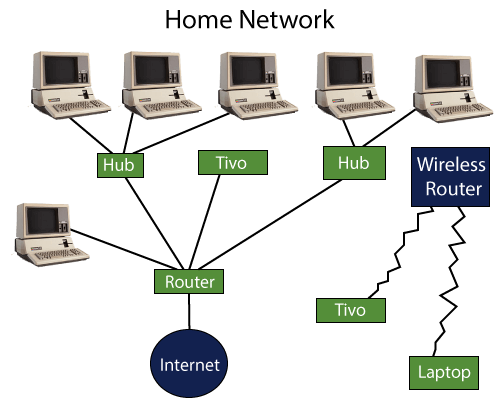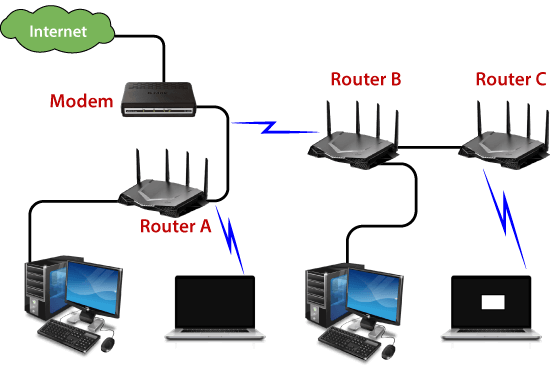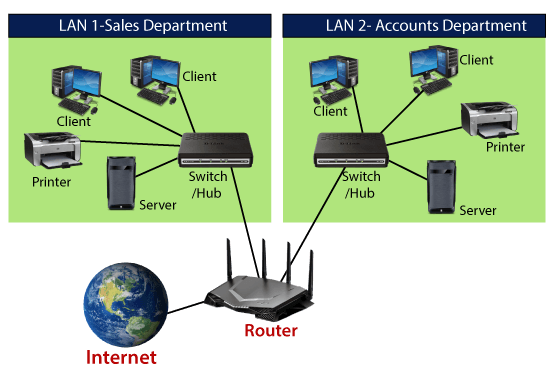The router is a physical or virtual internetworking device that is designed to receive, analyze, and forward data packets between computer networks. A router examines a destination IP address of a given data packet, and it uses the headers and forwarding tables to decide the best way to transfer the packets. There are some popular companies that develop routers;
such are Cisco Juniper, D-Link, Nortel, etc. Some important points of routers are given below:
- A router is used in LAN (Local Area Network) and WAN (Wide Area Network) environments.
- It shares information with other routers in networking.
- It uses the routing protocol to transfer the data across a network.
- Furthermore, it is more expensive than other networking devices like switches and hubs.

A router works on the third layer of the OSI model, and it is based on the IP address of a computer. It uses protocols such as ICMP to communicate between two or more networks. It is also known as an intelligent device as it can calculate the best route to pass the network packets from source to the destination automatically.
Why Routers?
A router is more capable as compared to other network devices, such as a hub, switch, etc., as these devices are only able to execute the basic functions of the network. For example, a hub is a basic networking device that is mainly used to forward the data between connected devices, but it cannot analyze or change anything with the transferring data. On the other hand, the router has the capability to analyze and modify the data while transferring it over a network, and it can send it to another network. For example, generally, routers allow sharing a single network connection between multiple devices.

How does Router work?
A router analyzes a destination IP address of a given packet header and compares it with the routing table to decide the packet's next path. The list of routing tables provides directions to transfer the data to a particular network destination. They have a set of rules that compute the best path to forward the data to the given IP address.
Routers use a modem such as a cable, fiber, or DSL modem to allow communication between other devices and the internet. Most of the routers have several ports to connect different devices to the internet at the same time. It uses the routing tables to determine where to send data and from where the traffic is coming.

A routing table mainly defines the default path used by the router. So, it may fail to find the best way to forward the data for a given packet. For example, the office router along a single default path instructs all networks to its internet services provider.
There are two types of tables in the router that are static and dynamic. The static routing tables are configured manually, and the dynamic routing tables are updated automatically by dynamic routers based on network activity.
Features of Router
- A router works on the 3rd layer (Network Layer) of the OSI model, and it is able to communicate with its adjacent devices with the help of IP addresses and subnet.
- A router provides high-speed internet connectivity with the different types of ports like gigabit, fast-Ethernet, and STM link port.
- It allows the users to configure the port as per their requirements in the network.
- Routers' main components are central processing unit (CPU), flash memory, RAM, Non-Volatile RAM, console, network, and interface card.
- Routers are capable of routing the traffic in a large networking system by considering the sub-network as an intact network.
- Routers filter out the unwanted interference, as well as carry out the data encapsulation and decapsulation process.
- Routers provide the redundancy as it always works in master and slave mode.
- It allows the users to connect several LAN and WAN.
- Furthermore, a router creates various paths to forward the data.
Applications of Routers
There are various areas where a router is used:
- It provides support for a fast rate of data transmission because it uses high STM links for connectivity; that's why it is used in both wired or wireless communication.
- Internet service providers widely use routers to send the data from source to destination in the form of e-mail, a web page, image, voice, or a video file. Furthermore, it can send data all over the world with the help of an IP address of the destination.
- Routers offer access restrictions. It can be configured in a way that allows for few users to access the overall data and allows others to access the few data only, which is defined for them.
- Routers are also used by software testers for WAN communications.
- In wireless networks, by configuring VPN in routers, it can be used in the client-server model, which allows sharing the internet, video, data, voice, and hardware resources. As shown in the below picture:

- In modern times, routers have the facility of inbuilt USB ports within the hardware. They have enough internal storage capacity. External storage devices can be used with routers to store and share data.
- Routers are used to set up the operation and maintenance center of an organization, which is known as the NOC center. All equipment at a distant location are connected by routers on optical cable at a central location, which also offer redundancy through the main link and protection link topology.
Types of Routers
There are various types of routers in networking; such are given below:
1. Wireless Router: Wireless routers are used to offer Wi-Fi connectivity to laptops, smartphones, and other devices with Wi-Fi network capabilities, and it can also provide standard ethernet routing for a small number of wired network systems.
Wireless routers are capable of generating a wireless signal in your home or office, and it allows the computers to connect with routers within a range, and use the internet. If the connection is indoors, the range of the wireless router is about 150 feet, and when the connection is outdoors, then its range is up to 300 feet.
2. Brouter: A brouter is a combination of the bridge and a router. It allows transferring the data between networks like a bridge. And like a router, it can also route the data within a network to the individual systems. Thus, it combines these two functions of bridge and router by routing some incoming data to the correct systems while transferring the other data to another network.
3. Core router: A core router is a type of router that can route the data within a network, but it is not able to route the data between the networks. It is a computer communication system device and the backbone of networks, as it helps to link all network devices. It is used by internet service providers (ISPs), and it also provides various types of fast and powerful data communication interfaces.
4. Edge router: An edge router is a lower-capacity device that is placed at the boundary of a network. It allows an internal network to connect with the external networks. It is also called as an access router. It uses an External BGP (Border Gateway Protocol) to provides connectivity with remote networks over the internet.
5. Broadband routers: Broadband routers are mainly used to provide high-speed internet access to computers. It is needed when you connect to the internet through phone and use voice over IP technology (VOIP).
Benefits of Router
There are so many benefits of a router, which are given below:
- Security:
- Performance enhancement:
- Reliability:
- Networking Range:
Routing Protocols
Routing protocols specify a way for the router to identify other routers on the network and make dynamic decisions to send all network messages. There are several protocols, which are given below:
Open Shortest Path First (OSPF):
Border Gateway Protocol (BGP):
Interior Gateway Routing Protocol (IGRP):
Enhanced Interior Gateway Routing Protocol (EIGRP):
Exterior Gateway Protocol (EGP):
Routing Information Protocol (RIP):
Difference between Bridge and Router
Sr. No. Key Router Bridge 1 Objective Router main objective is to connect various networks. Bridge main objective is to connect various LANs. 2 Layer Router works in Network Layer. Bridge works in Data Link Layer. 3 Address Router scans device's IP Address. Bridge scan device's MAC Address. 4 Data Format Router sends data in form of packets. Bridge also sends data in form of packets. 5 Routing Table Router uses routing table. Bridge do not use routing table. 6 Domain Router works on more than single broadcast domains. Bridge works on a single broadcast domain. 7 Ports Router has more than two ports. Bridge has only two ports There are three primarily networking devices that connect the computers from one to another. These devices are hub, switch, and router. The difference between a hub, switch, and router are given below:
Hub: A hub is a basic networking device that is used to connect computers or other networking devices together. A hub does not use any routing table to send the data to the destination. Although it can identify basic errors of networks like collisions, it can be a security risk to broadcast all information to the multiple ports. As the hub is a dumb device, it does not need an IP address. Furthermore, Hubs are cheaper than a switch or router.
Switch: A switch is a hardware device that also connects computers to each other. A switch is different as compared to a hub in that way; it handles packets of data. Whenever a switch receives a packet, it decides the device to which the packet can be sent, and sends it to that device only. A hub broadcasts the packet to all computers, but the switch does not circulate the packet to all devices, which means bandwidth is not shared with the network, and thus it increases the efficiency of the network. That's why switches are more preferred as compared to a hub.
Router: A router is more different from a switch or hub. It is mainly used to route the data packets to another network instead of transmitting the data to the local networks only. A router is commonly found in homes and offices as it allows your network to communicate with other networks through the internet. Basically, a router provides more features to your networks like firewall, VPN, QoS, traffic monitoring, etc.
What is Routing Table in Router?
A routing table determines the path for a given packet with the help of an IP address of a device and necessary information from the table and sends the packet to the destination network. The routers have the internal memory that is known as Random Access Memory (RAM). All the information of the routing table is stored in RAM of routers.
Comments
Post a Comment